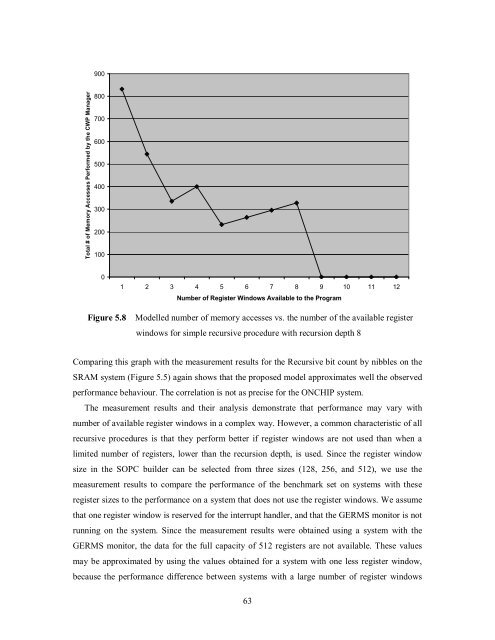Soft-Core Processor Design - CiteSeer
Soft-Core Processor Design - CiteSeer
Soft-Core Processor Design - CiteSeer
You also want an ePaper? Increase the reach of your titles
YUMPU automatically turns print PDFs into web optimized ePapers that Google loves.
Total # of Memory Accesses Performed by the CWP Manager<br />
900<br />
800<br />
700<br />
600<br />
500<br />
400<br />
300<br />
200<br />
100<br />
0<br />
1 2 3 4 5 6 7 8 9 10 11 12<br />
Number of Register Windows Available to the Program<br />
Figure 5.8 Modelled number of memory accesses vs. the number of the available register<br />
windows for simple recursive procedure with recursion depth 8<br />
Comparing this graph with the measurement results for the Recursive bit count by nibbles on the<br />
SRAM system (Figure 5.5) again shows that the proposed model approximates well the observed<br />
performance behaviour. The correlation is not as precise for the ONCHIP system.<br />
The measurement results and their analysis demonstrate that performance may vary with<br />
number of available register windows in a complex way. However, a common characteristic of all<br />
recursive procedures is that they perform better if register windows are not used than when a<br />
limited number of registers, lower than the recursion depth, is used. Since the register window<br />
size in the SOPC builder can be selected from three sizes (128, 256, and 512), we use the<br />
measurement results to compare the performance of the benchmark set on systems with these<br />
register sizes to the performance on a system that does not use the register windows. We assume<br />
that one register window is reserved for the interrupt handler, and that the GERMS monitor is not<br />
running on the system. Since the measurement results were obtained using a system with the<br />
GERMS monitor, the data for the full capacity of 512 registers are not available. These values<br />
may be approximated by using the values obtained for a system with one less register window,<br />
because the performance difference between systems with a large number of register windows<br />
63














